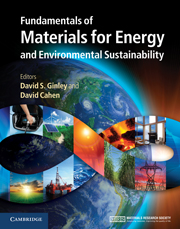Book contents
- Frontmatter
- Contents
- Contributors
- Preface
- Acknowledgments
- Part 1 Energy and the environment: the global landscape
- Part 2 Nonrenewable energy sources
- Part 3 Renewable energy sources
- Part 4 Transportation
- 31 Transportation: motor vehicles
- 32 Transportation: aviation
- 33 Transportation: shipping
- 34 Transportation: fully autonomous vehicles
- Part 5 Energy efficiency
- Part 6 Energy storage, high-penetration renewables, and grid stabilization
- Summary
- Appendix A Thermodynamics
- Appendix B Electrochemistry
- Appendix C Units
- Index
- References
31 - Transportation: motor vehicles
from Part 4 - Transportation
Published online by Cambridge University Press: 05 June 2012
- Frontmatter
- Contents
- Contributors
- Preface
- Acknowledgments
- Part 1 Energy and the environment: the global landscape
- Part 2 Nonrenewable energy sources
- Part 3 Renewable energy sources
- Part 4 Transportation
- 31 Transportation: motor vehicles
- 32 Transportation: aviation
- 33 Transportation: shipping
- 34 Transportation: fully autonomous vehicles
- Part 5 Energy efficiency
- Part 6 Energy storage, high-penetration renewables, and grid stabilization
- Summary
- Appendix A Thermodynamics
- Appendix B Electrochemistry
- Appendix C Units
- Index
- References
Summary
Focus
Motor vehicles consume about 19% of the world's total energy supplies, with 95% of this amount being petroleum, accounting for about 60% of the total world petroleum production [1]. In the USA about 80.5% of the motorized transportation energy is consumed by road vehicles [2]. The recent increase in petroleum prices, expanding world economic prosperity, the probable peaking of conventional petroleum production in the coming decades, regulations to increase fuel economy standards, concerns about global climate change, and the recent release of significant quantities of oil as a result of the failure of the deep-sea well in the Gulf of Mexico all suggest the need to focus efforts to increase the efficiency of the use of, and develop alternatives for, petroleum-based fuels used in road transportation. Efforts to increase the energy efficiency of a vehicle will require improvements in materials and processes for propulsion systems and structures, new advanced propulsion systems, batteries, and alternative fuels.
Synopsis
In many industrial countries, road transportation accounts for a significant portion of the country's energy consumption. In developing countries, the use of energy for transportation is on the rise. Most studies indicate that 70%–80% of the energy usage during the life cycle of a road transportation vehicle is in the use phase, including maintenance. The remainder is energy usage in the production of the vehicles, including the production of the materials, supply of the fuel, and disposing of the vehicles. Fuel economy and greenhouse-gas-emission regulations in North America, Japan, and Europe are forcing manufacturers to look into reducing fuel consumption in any cost-effective manner possible. Thus, advances in many materials and processes will be required in efforts to increase the energy efficiency of motorized vehicles for road transportation.
- Type
- Chapter
- Information
- Publisher: Cambridge University PressPrint publication year: 2011



